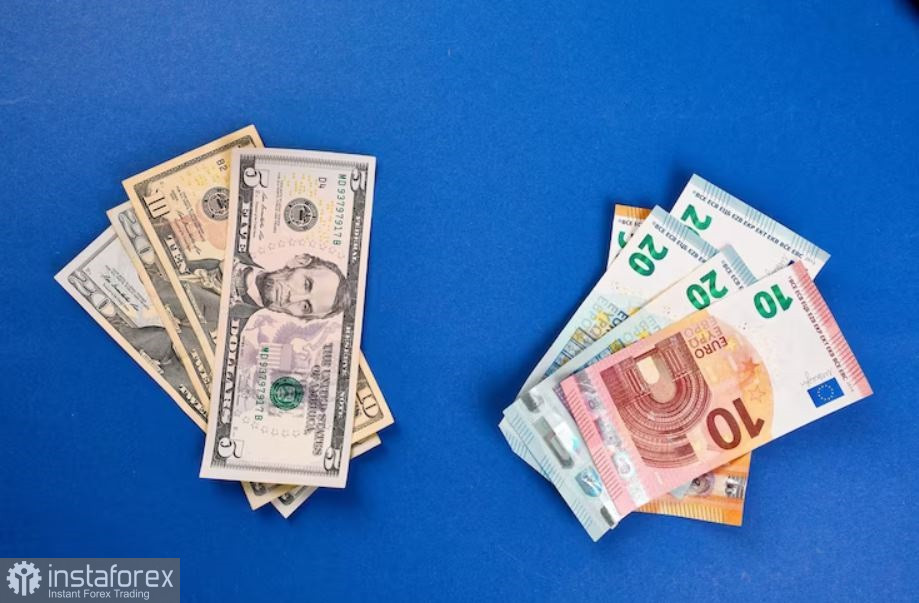The EUR/USD pair continues to trade within a broad range, awaiting key releases this week. Yesterday, EUR/USD bears attempted once again to break through the support level of 1.0950 (the middle line of the Bollinger Bands on the weekly chart) but failed to secure a position below this target. Throughout August, the pair's sellers have almost daily tried to settle at the base of the 1.09 level, but each time they revert back to the 1.10 price level boundaries. Thus, it can be confidently said that the pair will trade within the range of 1.0900–1.1000 until the release of the U.S. Consumer Price Index, that is, until the U.S. session on Thursday. Traders are trapped in a sideways trend—buyers and sellers are showing indecision ahead of this major release.

It's worth noting that the overall fundamental picture for the EUR/USD pair this week is somewhat bearish, primarily due to the rise in risk-averse sentiments in the markets and based on preliminary forecasts that inflation report will indicate an acceleration in U.S. inflation in July. Meanwhile, this week's economic calendar is almost empty, with the exception of the two main reports to be published on Thursday (Consumer Price Index) and Friday (Producer Price Index).
The surge in risk aversion occurred for two reasons. Firstly, China, and secondly, the Moody's agency.
This week, there's renewed talk that China might slow down global GDP, following the release of its foreign trade data. It was revealed that last month China's exports declined by 14.5% year-on-year (with a forecasted decline of 12.5%), amounting to nearly $282 billion – the lowest in the past five months. This rate of decline is the steepest since February 2020. The report structure shows that shipments to the U.S. dropped by 23%, to EU countries by 20%, and to the Association of Southeast Asian Nations (ASEAN) by almost 22%.
China's imports in July also decreased significantly by 12.4% (to $201.2 billion), with a projected decline of 5%—the steepest decline since May 2020. This component of the report shows a declining trend for the fifth consecutive month. Imports from the U.S. dropped by 11%, EU countries by 3%, ASEAN countries by 11%, Japan by 14.7%, and South Korea by a whopping 23%. Overall, for the first seven months of the current year, China's exports declined by 5%, while imports dropped by 7.6% year-on-year.
The published data is disappointing, primarily indicating a slowdown in demand. A decrease in imports indicates sluggish domestic demand in China, while a decrease in exports indicates a weakening global demand and a slowdown in the global economy. The overall somber conclusion is that China's recovery from the "COVID period" is at a pace weaker than the expectations of most experts.
Such conclusions triggered a surge in risk-averse sentiment in the markets. The safe-haven dollar became the primary beneficiary of the current situation, strengthening its position across the board, including against the euro.
Adding fuel to the fire was the rating agency Moody's, which downgraded the ratings of 10 small to medium-sized U.S. banks. Additionally, the agency placed the ratings of several larger banks, such as the Bank of New York Mellon, under review for potential downgrades. Following this, shares of American banks opened Tuesday's trading session with a drop in quotes. Specifically, Bank of America lost 3.7%, Goldman Sachs dropped by 3.3%, Morgan Stanley by 2.9%, and JPMorgan by 2.2%.
Commenting on their decision, representatives from Moody's mentioned that U.S. banks continue to face risks of the Federal Reserve raising interest rates, as well as asset and liability management issues, "affecting liquidity and capital."
This fundamental backdrop allowed bears in the EUR/USD to test the 1.0950 support level again, settling around the 1.0930 mark. However, dovish comments from Federal Reserve officials prevented them from firmly settling around the 1.09 mark. In particular, Philadelphia Federal Reserve President Patrick Harker stated yesterday that "a rate cut is likely to begin next year." New York Fed President John Williams voiced a similar stance, noting the possibility of rate cuts starting early in 2024, "depending on economic data." The same sentiment was also echoed by Federal Reserve Bank of Chicago President Austan Goolsbee, suggesting that the Federal Reserve should consider how long to keep the rates at such a high level. He also noted that the recent inflation figures "have been quite positive."
In light of such rhetoric, the significance of inflation reports, which will be published in the U.S. tomorrow (August 10) and the day after, is heightened. If the indicators are in the "red zone," the likelihood of another rate hike within the current cycle will further weaken, while the probability of a rate cut in the first half of 2024 will increase.
Given this backdrop, it is unlikely that EUR/USD traders will venture away from the 1.09 level before the release of the consumer price index. The pair is likely to remain trapped in a sideways movement, ranging between 1.0900 and 1.1000, until the crucial moment.





















